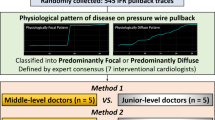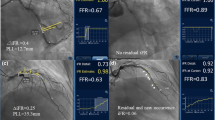Abstract
Using data from a commercial pressure wire system (St. Jude Medical) we previously developed an automated “smart” algorithm to determine a reproducible value for minimum FFR (smFFR) and confirmed that it correlated very closely with measurements made off-line by experienced coronary physiology core laboratories. In this study we used the same “smart” minimum algorithm to analyze data derived from a different, commercial pressure wire system (Philips Volcano) and compared the values obtained to both operator-defined steady state FFR and the online automated minimum FFR reported by the pressure wire analyser. For this analysis, we used the data collected during the VERIFY 2 study (Hennigan et al. in Circ Cardiovasc Interv, doi:10.1161/CIRCINTERVENTIONS.116.004016) in which we measured FFR in 257 intermediate coronary stenoses (mean DS 48%) in 197 patients. Maximal hyperaemia was induced using intravenous adenosine (140 mcg/kg/min). We recorded both the online minimum FFR generated by the analyser and the operator-reported steady state FFR. Subsequently, the raw pressure tracings were coded, anonymised and 256/257 were subjected to further off-line analysis using the smart minimum FFR (smFFR) algorithm. The operator-defined steady state FFR correlated well with smFFR: r = 0.988 (p < 0.001), average bias 0.008 (SD 0.014), 95% limits of agreement −0.020 to 0.036. The online automated minimum FFR also correlated well with the smFFR: r = 0.998 (p < 0.001), average bias 0.004 (SD 0.006), 95% limits of agreement −0.016 to 0.008. Finally, the online automated minimum FFR correlated well the operator-reported steady state FFR: r = 0.988 (p < 0.001), average bias 0.012 (SD 0.014), 95% limits of agreement −0.039 to 0.015. In 95% of lesions studied (244/256), the operator reported steady-state FFR, smFFR, and online automated minimum FFR agreed with each other to within 0.04, which is within the previously reported test/retest limits of agreement of FFR reported by an experienced core lab. Disagreements >0.05 among methods were rare but in these cases the two automated algorithms almost always agreed with each other rather than with the operator-reported value. Within the VERIFY 2 dataset, experienced operators reported a similar FFR value to both an online automated minimum (Philips Volcano) and off-line “smart” minimum computer algorithm. Thus, treatment decisions and clinical studies using either method will produce nearly identical results.




Similar content being viewed by others
References
Desai NR, Bradley SM, Parzynski CS et al (2015) Appropriate use criteria for coronary revascularization and trends in utilization, patient selection, and appropriateness of percutaneous coronary intervention. JAMA 314:2045–2053
Tebaldi M, Biscaglia S, Pecoraro A, Fineschi M, Campo G (2016) Fractional flow reserve implementation in daily clinical practice: a European survey. Int J Cardiol 207:206–207
Pijls NHJ, Fearon WF, Tonino PAL et al (2010) Fractional flow reserve versus angiography for guiding percutaneous coronary intervention in patients with multivessel coronary artery disease. J Am Coll Cardiol 56:177–184
Pijls NHJ, van Schaardenburgh P, Manoharan G et al (2007) Percutaneous coronary intervention of functionally nonsignificant stenosis. J Am Coll Cardiol 49:2105–2111
De Bruyne B, Fearon WF, Pijls NHJ et al (2014) Fractional flow reserve–guided PCI for stable coronary artery disease. N Engl J Med 371:1208–1217
Nijjer SS, Sen S, Petraco R et al (2014 Dec) Pre-angioplasty instantaneous wave-free ratio pullback provides virtual intervention and predicts hemodynamic outcome for serial lesions and diffuse coronary artery disease. J Am Coll Cardiol Cardiovasc Interv 7(12):1386–1396
Tarkin JM, Nijjer S, Sen S et al (2013) Hemodynamic response to intravenous adenosine and its effect on fractional flow reserve assessment: results of the Adenosine for the Functional Evaluation of Coronary Stenosis Severity (AFFECTS) Study. Circ Cardiovasc Interv 6:654–661
Hennigan B, Oldroyd KG, Berry C (2016)et al. Discordance between resting and hyperemic indices of coronary stenosis severity: the VERIFY 2 Study (A comparative study of resting coronary pressure gradient, instantaneous wave-free ratio and fractional flow reserve in an unselected population referred for invasive angiography). Circ Cardiovasc Interv. doi:10.1161/CIRCINTERVENTIONS.116.004016
Johnson NP, Johnson DT, Kirkeeide RL et al (2015) Repeatability of fractional flow reserve despite variations in systemic and coronary hemodynamics. J Am Coll Cardiol Cardiovasc Interv 8:1018–1027
Berry C, van’t Veer M, Witt N, Kala P, Bocek O, Pyxaras SA et al (2013) VERIFY (VERification of Instantaneous Wave-Free Ratio and Fractional Flow Reserve for the Assessment of Coronary Artery Stenosis Severity in EverydaY Practice): a multicenter study in consecutive patients. J Am Coll Cardiol 61(13):1421–1427
Acknowledgements
We thank our patients, medical, nursing and cardiac physiology staff who supported this study. Dr. Hennigan was supported by British Heart Foundation Project Grant PG/14/97/31263 and an institutional grant from the British Heart Foundation RE/13/5/30177 to the University of Glasgow.
Author information
Authors and Affiliations
Corresponding author
Ethics declarations
Conflict of interest
The authors declare that they have no conflict of interest.
Disclosures
There was no industry involvement in any aspect of this study. Professor Berry has undertaken research, consulting and lectures for St. Jude Medical based on contracts with The University of Glasgow. Professor Oldroyd has received honoraria for consultancy and lectures from St. Jude Medical and Volcano Corporation. NPJ receives internal funding from the Weatherhead PET Center for Preventing and Reversing Atherosclerosis; and significant institutional research support from St. Jude Medical (for NCT02184117) and Volcano/Philips Corporation (for NCT02328820), makers of intracoronary pressure and flow sensors. His institution (UTHealth) has a licensing agreement with Boston Scientific for the smFFR algorithm.
Rights and permissions
About this article
Cite this article
Hennigan, B., Johnson, N., McClure, J. et al. Validation of the “smart” minimum FFR Algorithm in an unselected all comer population of patients with intermediate coronary stenoses. Int J Cardiovasc Imaging 33, 991–997 (2017). https://doi.org/10.1007/s10554-017-1126-y
Received:
Accepted:
Published:
Issue Date:
DOI: https://doi.org/10.1007/s10554-017-1126-y




